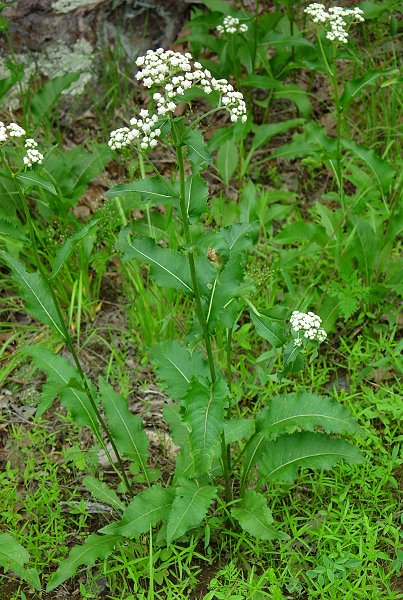Parthenium integrifolium L.
Wild Quinine

Native
CC = 6
CW = 5
MOC = 68
© DETenaglia
Parthenium integrifolium L.Wild Quinine | |
 |
Native CC = 6 CW = 5 MOC = 68 |
© DETenaglia |
|
Family - Asteraceae/Heliantheae Habit - Perennial forb with a somewhat thickened, tuberous rootstock, and occasionally a short rhizome. Stems - Erect, to 1 m, usually unbranched below the inflorescence, glabrous to moderately pubescent with loosely ascending hairs, sometimes also with minute, sessile, spherical, yellow glands.
Leaves - Alternate, petiolate to sessile, scabrous. Basal and lower stem leaves long-petiolate, the blades 12-30 cm long, elliptic to ovate, long-tapered to the petiole at the base, angled or tapered to a bluntly or sharply pointed tip, unlobed or those of the largest leaves rarely with a few short lobes toward the base, the margins otherwise coarsely toothed or scalloped, the upper surface sparsely to moderately roughened-pubescent with short, stiff hairs, the undersurface moderately to densely pubescent with short or longer, stiff, spreading hairs, both surfaces also usually with minute, sessile, spherical, yellow glands. Median and upper stem leaves short-petiolate to sessile, the blade mostly 2-15 cm long, lanceolate to ovate, angled or tapered to the petiole or, in sessile leaves, often rounded to shallowly cordate and sometimes somewhat clasping the stem, the margins and surfaces more or less like those of the lower leaves. Stem leaves with moderate, more or less appressed hairs along the undersurface midvein.
Inflorescence - More or less flat-topped dense corymbiform arrangement of flower heads terminating stems. Peduncles densely pubescent with multicellular hairs. Small bracts present at divisions of inflorescence and often subtending involucre.
Heads - Involucres 3-6 mm long, 4-10 mm in diameter, the bracts of the outer series slightly shorter than the others, lanceolate to broadly ovate, those of the inner series broadly ovate to nearly circular. Phyllaries densely covered with multicellular pubescence. Receptacle convex to short-conical, with chaffy bracts subtending the ray and disc florets, these densely hairy on the outer surface toward the tip, those of the disc florets concave and wrapped around the florets.
Flowers - Ray florets 5, pistillate, the corolla with a short (1-2 mm), broad, or rarely absent ligule, white or off-white, the short, tubular base (and the outer surface of the ligule) densely short-hairy, usually persistent at fruiting. Disc florets about 15-65, staminate (with a small, stalklike ovary and an undivided style), all but the outermost florets usually shed as an intact unit at fruiting, the corolla 1.2-2.0 mm long, off-white to pale cream-colored, minutely hairy on the outer surface of the lobes, not expanded at the base. Style branches with the sterile tip broad and bluntly pointed to rounded. Pappus of the disc florets usually absent, that of the ray florets of 2 or 3 slender awns 0.2-0.5 mm long.
Fruits - Achenes 3-5 mm long, black at maturity. Flowering - May - October. Habitat - Glades, upland prairies, savannas, forest openings, bluffs, pastures, railroads, roadsides. Origin - Native to the U.S. Lookalikes - P. hispidum. Other info. - This species is common throughout most of Missouri except for the extreme northwestern corner of the state, where it is uncommon or absent. Its wider distribution is unusual in shape, with a cluster in several Midwestern states centered on Missouri, and another lobe extending eastward to the Atlantic Coast. It is a relatively easy species to identify, having clusters of small, white heads, each usually bearing five tiny ray ligules, and large, toothed leaves with a rough texture. Another species, P. hispidum Raf., is similar but usually grows in dense colonies and has more conspicuous, spreading hairs on its stems and leaves. These two species have sometimes been considered varieties of a single species. Photographs taken off Hwy 106, Shannon County, MO., 5-26-03, and on Taum Sauk Mountain, MO., 5-31-03 (DETenaglia); also at St. Joe State Park, St. Francois County, MO, 6-10-2013; Bootleg Access, Washington County, MO, 6-29-2022, and Western Star Flatwoods, Phelps County, MO, 6-23-2023 (SRTurner). |